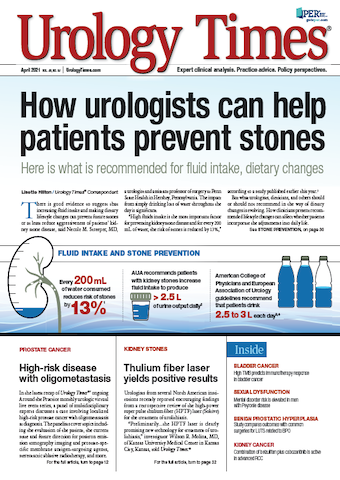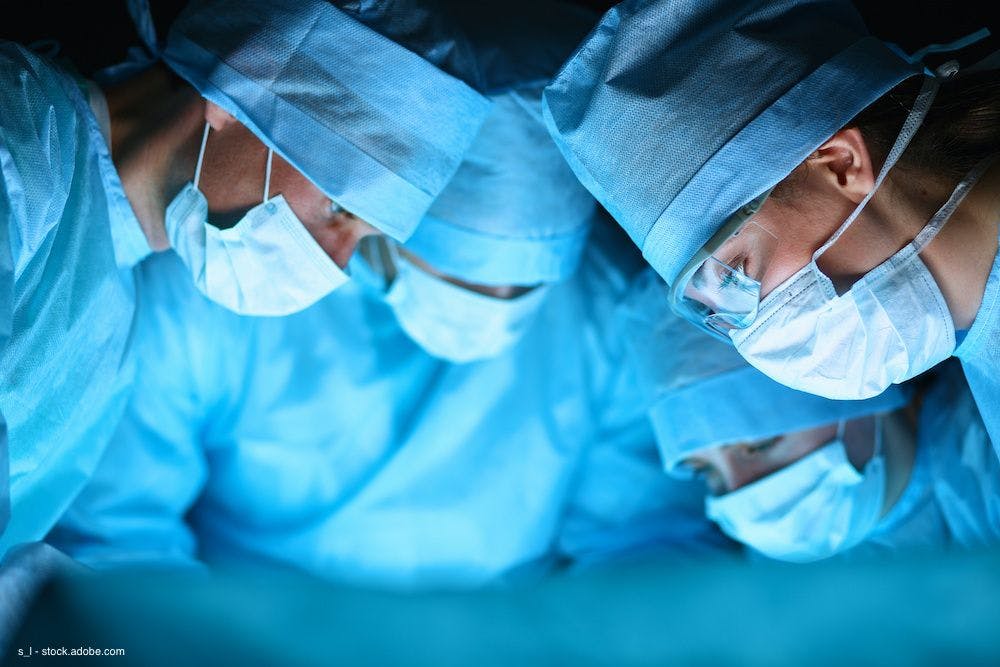Publication
Article
Urology Times Journal
Freehand transperineal prostate biopsy case series and review support widespread use
Author(s):
The technique is safer and more accurate than transrectal biopsy, an investigator says.
A recently published case series and a literature review looking at use of the freehand transperineal prostate biopsy under local anesthesia demonstrate the feasibility of incorporating this safer, more accurate approach to prostate biopsy into the urology clinic workflow.
“Many centers around the world have adopted freehand transperineal prostate biopsy because it virtually eliminates sepsis, may improve detection rates of clinically significant prostate cancer, and can be easily integrated into a normal clinic workflow using only local anesthesia. If all urologists in the United States abandoned transrectal prostate biopsy for freehand transperineal prostate biopsy, the potential savings in health care costs of complications would be significant,” the author concluded in the review published online in the Journal of Endourology.1
Many urologists are switching to the transperineal approach because of the increasing rates of sepsis post transrectal prostate biopsy, despite use of empirical or targeted antibiotic prophylaxis, according to review author Richard Julius Szabo, MD, a urologist with Kaiser Permanente in Irvine, California, an associate clinical professor of urology at the University of California, Irvine, School of Medicine, and volunteer urology faculty at the Veterans Administration Healthcare System in Long Beach, California. Szabo also authored results of a case series of 242 consecutive freehand transperineal biopsies performed between August 26, 2016, and December 31, 2018, published online in the Journal of Endourology.2
“This approach virtually eliminates sepsis complications, as shown both by review of the literature and the fact that of the 242 consecutive freehand transperineal biopsies performed, 212 (88%) received no antibiotic prophylaxis and none developed sepsis,” Szabo said. “Recent evidence also shows that when the transperineal approach is coupled with MRI/ultrasound fusion targeting, the yield of clinically significant cancer is 50% to 60% greater than the yield with transrectal MRI/ultrasound fusion targeting. This more accurate yield is even more pronounced in anteriorly located clinically significant prostate cancer that in one study was detected 3.5 times more frequently when employing the transperineal approach compared to the yield detected using the transrectal approach.”
Technique is easily incorporated in clinic workflow
The freehand transperineal prostate biopsy under local anesthesia is easily incorporated into a normal outpatient clinic workflow, he noted. An increasing number of academic centers in the United States are using the transperineal approach, including Johns Hopkins, Massachusetts General Hospital, Mayo Clinic, Northwestern University, the University of Connecticut, and the University of Michigan, according to Szabo. Soon patients will insist on this safer, more accurate approach to prostate biopsy, he said.
“Furthermore, the Centers for Medicare and Medicaid Services and major insurers will become aware that if all urologists in the United States switched to freehand transperineal prostate biopsy under local anesthesia, the potential savings in eliminating the estimated 39,400 admissions for posttransrectal biopsy sepsis will amount to between $341,676,800 and $752,540,000, a savings of $173 to $382 for every transrectal biopsy performed,” Szabo said. This does not include the additional savings in eliminating emergency department visits through the elimination of posttransrectal biopsy rectal bleeding, which occurs in 2.5% of cases, and the reduction in posttransrectal biopsy urinary tract infections and prostatitis, which occur in 5% to 7%, respectively, Szabo said.
Szabo conducted the case series using the PrecisionPoint Transperineal Access System (Perineologic), an FDA-approved needle guide that has been on the market since 2016. It maintains the biopsy needle in the ultrasound image sagittal plane and adjusts for anterior and posterior targeting while maintaining the coaxial introducer in the same skin puncture site, according to Szabo.
Limitations of the freehand transperineal prostate biopsy approach include that it takes an average 19.1 minutes to perform versus the transrectal approach, which takes an average 14.7 minutes. Pain scores with the transperineal approach were slightly higher at a pooled average of 3.17 out of 10 compared to 2.6 out of 10 for the transrectal prostate biopsy, according to Szabo.
“This might be ameliorated with improved local anesthesia techniques and periprocedural anti-anxiety or pain medication,” Szabo said.
References
1. Szabo RJ. Free-hand transperineal prostate biopsy under local anesthesia in the office without antibiotic prophylaxis: experience with 304 cases. J Endourol. Published online February 11, 2021. doi:10.1089/end.2020.1086
2. Szabo RJ. “Free-hand” transperineal prostate biopsy under local anesthesia: review of the literature. J Endourol. Published online February 17, 2021. doi:10.1089/end.2020.1093
































